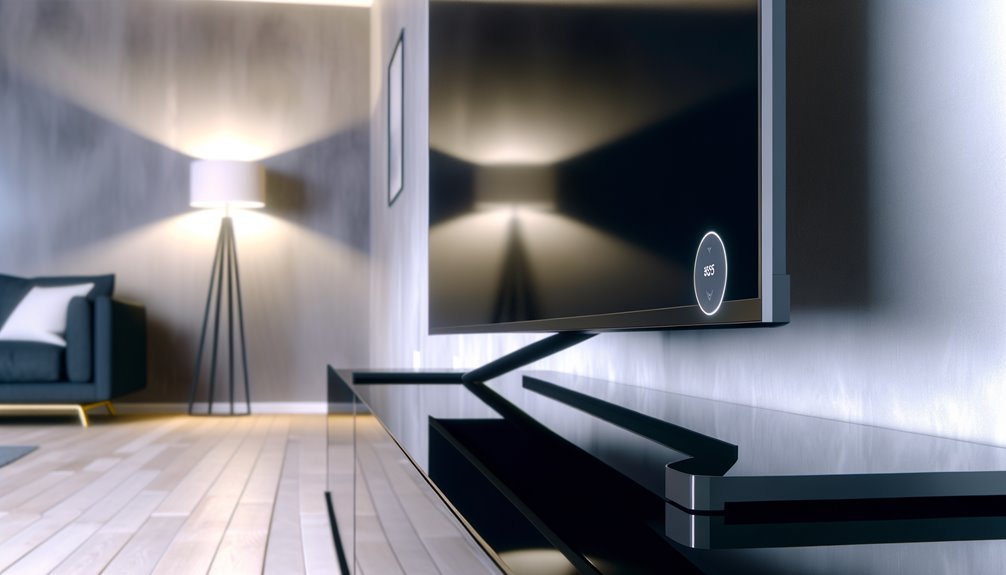Lets get straight to it: TV Stand Vs Wall Mount Whats Better? A wall mount offers a sleek, modern look and frees up floor space, making it ideal for smaller rooms.
It’s perfect for clean TV cable management but requires precise installation, often needing professional help.
A TV stand, though bulkier, integrates well with existing furniture and is easier to set up without tools. It also provides extra storage but can clutter the room and pose safety risks, especially with kids or pets around.
Wall mounts generally enhance safety and viewing angles, whereas stands offer flexibility in placement.
Depending on your priorities, you might find one option better suited to your needs and lifestyle.
Key Information
- Wall mounts offer a clean, modern look and free up floor space.
- TV stands provide flexibility in placement and easier installation.
- Wall mounts ensure better cable management and a clutter-free environment.
- TV stands can integrate into existing decor and provide additional storage.
- Wall mounts enhance safety by minimizing the risk of tipping accidents.
Aesthetics
Choosing between a wall mount and a TV stand greatly impacts the aesthetics of your living space. Wall mounts offer a clean, modern look by sitting the TV flush against the wall, making your room feel more open and less cluttered.
They excel in providing a sleek, seamless appearance and allow for ideal viewing height and angle adjustments, reducing glare and ensuring eye-level viewing.
On the other hand, TV stands provide flexibility with placement and can be integrated into existing furniture and decor. They also offer easy access to ports and can tie the TV into your living room’s overall style. Ultimately, your choice depends on whether you prioritize a modern, decluttered look or flexible, decor-integrated placement.
Installation Ease
When evaluating installation ease, wall mounts often present more complexity, requiring precise stud location and drilling, while TV stands typically offer a quicker, less invasive setup.
Wall mounting your TV demands careful planning and precise execution—locating studs, guaranteeing level drilling, and securing the bracket. This complexity often necessitates hiring a professional to wall mount your TV which ensures safety and stability.
Conversely, TV stands require minimal effort, usually involving straightforward assembly without the need for tools like drills or stud finders. You can often set up a TV stand within minutes, blending it seamlessly into your existing furniture and décor.
While wall mounts do provide a sleek, minimalist look, TV stands offer simplicity and ease, making them an attractive option for many.
Cable Management
When it comes to cable management, wall mounts excel by allowing you to discreetly run cables through the mount or wall, creating a clean, wireless look that enhances your TV setup’s aesthetic appeal. This method keeps your space clutter-free and maintains a seamless appearance.
In contrast, TV stands often have cables more likely to dangle, requiring additional cable management solutions like clips or sleeves to organize cords effectively. While you can still achieve a tidy look with a TV stand, it demands more effort and creativity.
Wall mounts inherently offer a superior, organized solution, concealing all unsightly wires and contributing to a more streamlined and visually pleasing home entertainment environment.
Cost Comparison
Investing in a TV stand or wall mount involves weighing the initial purchase price against long-term costs and potential additional expenses like installation fees.
TV stands range from £50 for basic models to over £500 for high-end designs, offering aesthetic benefits but potentially higher long-term costs if replacement or upgrades are needed.
Wall mounts are typically more budget-friendly, starting at £20 and reaching up to £200 for advanced features. However, factor in the average cost of TV mounting services, which can range from £120 to £370, depending on complexity.
While wall mounts may offer long-term savings, consider the initial installation fees if professional help is required. Balancing these costs will guide you to a smarter investment choice.
Safety and Security
Wall mounts greatly enhance safety and security by firmly attaching your TV to the wall, thereby minimizing the risk of tipping accidents.
In households with children or pets, TV stands can be particularly hazardous, as they’re prone to tipping over. By opting for a wall mount, you guarantee stability and eliminate the risk of your TV being accidentally knocked over.
Proper installation of wall mounts greatly reduces accidents and injuries associated with unstable TV stands. If safety is your top priority, a wall mount is the superior choice. It secures your TV effectively, providing peace of mind and a safer environment for everyone in your home.
Make an informed decision by prioritizing the stability and security that wall mounts offer.
Space Utilization
Maximizing your living space becomes much easier with a wall mount, as it keeps the TV flush against the wall, freeing up valuable floor area. This setup is particularly beneficial for small rooms or areas with limited space, allowing you to utilize every inch more effectively. Wall mounts also offer a sleek, modern look that helps declutter your room, enhancing its aesthetic appeal.
On the other hand, TV stands, while more space-consuming due to their freestanding design, provide additional storage options for media devices, books, or decorative items. However, the trade-off is the extra floor space they occupy.
If storage isn’t a priority, a wall mount is the more practical choice for efficient space utilization and a cleaner, streamlined room.
Frequently Asked Questions
Is It Better to Mount a TV on a Wall or Stand?
You should consider a wall mount for a sleek, space-saving look, offering customizable height. Opt for a TV stand if you need flexibility in TV position, additional storage, and easier relocation. Choose based on your priorities.
Which Is Better, Wall Mount or Stand?
You’ll find wall mounts give a sleek, modern look, ideal for large setups and hiding cables. TV stands, however, offer flexibility and are easier to set up, blending well with existing decor and providing practical placement options.
What Are the Disadvantages of Wall Mounted Tv?
You’ll face challenges with wall mounts like limited swiveling, tricky cord concealment, and restricted port accessibility. Installation requires tools and precision, and they don’t offer storage like TV stands do.
Do TVs Look Better Wall Mounted?
Yes, TVs look better wall mounted. You’ll achieve a sleek, modern aesthetic by eliminating visible stands and cables. Wall mounting also optimizes viewing angles, enhancing your visual experience while maintaining a clean, clutter-free environment.
Conclusion
When choosing between a TV stand and a wall mount, consider what suits your needs best.
A wall mount offers a sleek, modern look and saves space, but it requires precise installation. A TV stand, while easier to set up and manage cables, occupies floor space.
Both options vary in cost and safety. Ultimately, your choice hinges on balancing aesthetics, practicality, and budget.
Evaluate your priorities to make the best decision for your space.
For a seamless process and peace of mind. Book your TV installation appointment now by hitting the BOOK NOW flashing botton.



